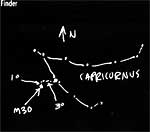
Observation Notes:
 This was a rewarding cluster to observe. It was a pleasant sight at 38X, 120X, and 240X. At 120 and 240 X, it began to resolve into stars along the edges. Several were constantly visible, with many more forming a granular splat just east of a bright 8.6 mag star (SAO 190531). A couple seeming appendages sprayed off the north and northwest sides, consisting of at least 4 stars for the northwest streamer and at least 2 stars for the northern one. The core verged on stellar, but not quite. If I had sketched at 240X, I could have done a better job plotting star positions across the surface, but there wasn't time for a second sketch (rising moon). It was circular overall, but seemed to have a flat edge to the core region along the south side. I estimated it's visual extent at 3'.
This was a rewarding cluster to observe. It was a pleasant sight at 38X, 120X, and 240X. At 120 and 240 X, it began to resolve into stars along the edges. Several were constantly visible, with many more forming a granular splat just east of a bright 8.6 mag star (SAO 190531). A couple seeming appendages sprayed off the north and northwest sides, consisting of at least 4 stars for the northwest streamer and at least 2 stars for the northern one. The core verged on stellar, but not quite. If I had sketched at 240X, I could have done a better job plotting star positions across the surface, but there wasn't time for a second sketch (rising moon). It was circular overall, but seemed to have a flat edge to the core region along the south side. I estimated it's visual extent at 3'.
Factoids:
M30 lies about 26,000 light years away and is about 90 light years across. Its core is very small, measuring about 7" across, for a diameter of 0.9 light years. It is approaching us at 181.9 km/sec.
It was first discovered by Charles Messier in 1764. William Herschel first resolved it into stars in 1784. The 2 streamers of stars that jumped out at me during the observation were also noted by Herschel: "Towards the north, are two rows of bright stars 4 or 5 in a line."
| Subject | M30 (NGC 7099) | |
| Classification | Globular Cluster (Class V) | |
| Position* | Capricornus [RA: 21:40:24 / Dec: -23:11:00] | |
| Size* | 12,0' | |
| Brightness* | 7.2 | |
| Date/Time | August 27, 2005 - 12:10 AM (August 28, 2005 - 07:10 UT) | |
| Observing Loc. | Flagstaff, AZ - Home | |
| Instrument | Orion SVP 6LT Reflector (150 mm dia./1200 mm F/L) | |
| Eyepieces/Mag. | 10 mm (120X) | |
| Conditions | Clear, calm, 64� F | |
| Seeing | ~4/10 | |
| Transparency | Mag 5.2 NELM | |
| Sources | SEDS |
*Based on published data.




